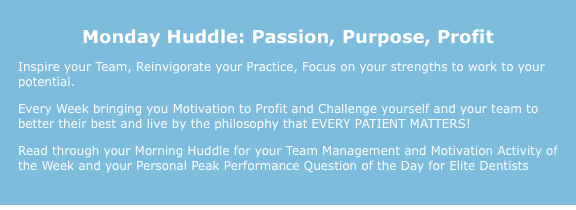Today, we are going to focus on ‘state of ideal’ when it comes to communication and your patients doing exactly as you say and your system for handoffs going exactly the way you want.
Later this month, we’ll move on to the wild and crazy questions from your patients as well as flat out obstinate rejections and objections that you have to deal with on a daily basis.
Before we get to those, we will first focus on doing it the right way. If you seriously commit to this approach, you will be surprised how objections just never appear and you are able to seamlessly move your patients forward with the treatment they need, want and deserve.
I’m asked all the time for the “step by step” approach (in other words: the cookie cutter answers), to very complex and ever-changing situations.
That is the first big mistake. To think there is one set method or checklist of BS to go through for every patient that will lead you down to “yes” and make your life so easy.
This is not the case and you shouldn’t want it to be; because: every patient is different.
Their past experiences, their preconceived ideas, their levels of fear and anxiety among many other things. If there was ‘one’ method then you would either be under or over promising all the patients. Instead, you will always be right if you treat every single patient as an individual and you customize the care and experience.
As I tell you nearly every single week: dentistry should be something that happens WITH someone not TO someone. If you master that – patient as participant – you will be amazed at the results you get.
This week we will focus on the tactics leading up to the diagnosis. We are going to review the approach to handoffs to piggyback on the previous Monday Huddle’s about communication and transfers (triangle of trusts).
First, for every patient, your greatest ability to have success each day is to have completed a chart review, photo review and clinically discussed the status of every existing patient (or to have dialogued through the phone conversation that was had with any incoming new patient).
This part can’t be missed. No professionals begin a day without proper preparation. I can’t emphasize this enough. Because when you do this properly you achieve three things…
1 – You miss much less opportunity and therefore maximize every patient experience
2 – You have much better team work and awareness which will lead to more patient engagement
3 – You will put your subconscious mind to work for you and you will be able to stay more present with your patients
If you do not prepare, you will default to just going through the motions.
You know the expression an ounce of prevention is worth a pound of cure. This is true. Sadly, there is no cure for missed diagnosis or lost opportunity because most patients don’t return (even when you think they will) and most patients have zero commitment to treatment that has been dictated to them that they have not been fully engaged in as participant.
At the time of greeting the patient, the business team should be reinforcing why the patient is here and then through the handoff to the clinical team member immediately showing the patient that he/she is not a number but an individual and that you have prepared for today’s visit.
This is so important to the patient. Even when you think it’s not, it is. It makes more difference than you will ever know.
Now, we could move right on to what is probably the most overlooked part of the patient experience and the most under utilized handoff of them all… the set-up, preparation for, transfer and handoff to the doctor.
But, we would be moving too fast and not focusing on mastering and making the most of every intricate part.
So today, I want you to really assess and ask yourself: do you know and are you prepared enough for every single patient visit for today – everyday? This is why I believe in dividing and conquering with column ownership.
And then you must ask yourself: are you gaining patient engagement, expressing your awareness of why they are there (even for a simple routine cleaning) and properly engaging the patients from the very beginning of their experience – THE MOMENT THEY WALK THROUGH THE DOOR?
These are such important questions before we proceed any further.



